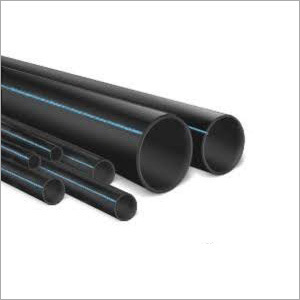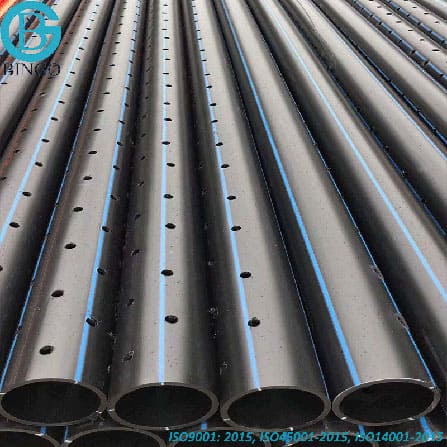Texas hdpe pipe manufacturer: Sustainable Innovations
Wiki Article
Check Out the Production Process Behind High-Quality HDPE Pipe and Its Applications
The production procedure of high-quality HDPE pipelines is intricate and methodical. It starts with the choice of raw materials that enhance performance. Following this, ethylene undergoes polymerization to create material, which is after that shaped with extrusion. Quality assurance is extremely important, ensuring that the end product meets stringent requirements. Nonetheless, the trip of HDPE pipes does not end with manufacturing. Their applications throughout different sectors expose a more comprehensive value worth analyzing.Comprehending HDPE: Residences and Advantages

High-density polyethylene (HDPE) is a versatile thermoplastic recognized for its durability and resistance to different ecological aspects. This product shows excellent tensile toughness, making it ideal for demanding applications. Its low-density structure adds to a light-weight item, helping with convenience of managing and installment. HDPE likewise showcases exceptional resistance to chemicals, which decreases degradation when revealed to extreme materials.
The material's reduced moisture absorption additionally improves its longevity, making it excellent for use in pipelines and storage tanks. In addition, HDPE is immune to ultraviolet (UV) radiation, ensuring that products keep their honesty even when subjected to sunshine. Its flexibility permits for the development of elaborate shapes without jeopardizing stamina. The environment-friendly nature of HDPE, typically originated from recycled products, includes to its charm, advertising sustainable techniques in production. Generally, these properties and benefits make HDPE a favored selection for different industrial and consumer applications.
Resources Choice for HDPE Manufacturing
The choice of resources for HDPE manufacturing is vital to verify the final item meets the preferred specifications and top quality standards. High-density polyethylene (HDPE) is primarily produced from polymerized ethylene, acquired from nonrenewable fuel sources such as all-natural gas or crude oil. The quality of these feedstocks considerably influences the mechanical and thermal homes of the final HDPE.Additives additionally play a considerable function in enhancing HDPE's performance, consisting of antioxidants, UV stabilizers, and colorants, which enhance durability and resistance to ecological aspects. The selection process should consider not just the chemical composition of the raw materials but additionally their processing qualities to ensure effective manufacturing.
The sourcing of raw products should prioritize sustainability and compliance with ecological guidelines, as responsible methods are imperative in today's market. Inevitably, cautious resources choice lays the structure for generating premium HDPE pipes appropriate for diverse applications.
The Extrusion Process: Shaping HDPE Pipeline
The extrusion process plays an essential duty in shaping HDPE pipelines, starting with meticulous material preparation techniques that assure suitable circulation and uniformity. Equally important is the design of the die, which directly influences the final measurements and surface high quality of the pipeline. Together, these aspects contribute considerably to the effectiveness and high quality of HDPE pipe production.Product Preparation Techniques
Effective production of HDPE pipes begins with careful product preparation methods, particularly the extrusion procedure. During this stage, high-density polyethylene material is very first dried out to eliminate moisture, ensuring suitable flow attributes. The resin is after that fed right into the extruder, where it undertakes heating and melting, transforming into a viscous state. This home heating process is carefully regulated to maintain the product's integrity and efficiency. The liquified HDPE is forced with a die, shaping it into a continuous pipeline form. Proper temperature administration during extrusion is vital, as it straight impacts the material's homes and the end product top quality. As soon as formed, the HDPE pipe is cooled and cut to defined lengths, ready for succeeding handling and applications.Die Layout Significance
Accuracy in die layout plays an important duty in the extrusion procedure of HDPE pipelines. The die works as the final shaping device, straight influencing the pipe's dimensions, wall thickness, and surface coating. A properly designed die warranties consistent material circulation, lowering defects such as irregularities and vulnerable points. The geometry of the die need to be optimized to fit the certain residential properties of HDPE, including its viscosity and thermal behavior throughout extrusion. In addition, the cooling price of the material as it goes through the die can considerably impact the pipeline's architectural honesty. Subsequently, spending in innovative die modern technology is essential for makers intending to create top notch HDPE pipelines that satisfy market requirements and consumer assumptions.Quality Assurance Measures in HDPE Production
Although numerous elements affect the quality of HDPE pipe production, efficient quality assurance measures are important to assure uniformity and reliability in the end product. Secret top quality control techniques include strenuous product assessment, validating that the raw polyethylene meets well-known criteria for purity and thickness. During the extrusion process, criteria such as temperature, stress, and cooling time are very closely checked to preserve dimensional accuracy and structural integrityAdditionally, post-production testing is essential; manufacturers usually conduct hydrostatic tests to examine the pipe's toughness and resistance to stress. Aesthetic evaluations for surface area issues better boost quality control. Qualification from appropriate standards organizations, like ASTM or ISO, supplies an additional layer of credibility. By carrying out these thorough quality control actions, producers can lessen defects, boost performance, and make certain that the HDPE pipelines meet the details demands of different applications, inevitably causing consumer contentment and count on in the product.
Applications of HDPE Pipeline Across Industries
HDPE pipes are made use of across various markets as a result of their durability and flexibility. In water circulation systems, they ensure effective delivery, while in wastewater administration, they supply reputable options for waste transportation. Additionally, agricultural irrigation networks gain from HDPE's resistance to corrosion and flexibility, making it a suitable option for modern-day farming methods.
Water Circulation Systems
A substantial variety of markets depend on high-density polyethylene (HDPE) pipelines for reliable water circulation systems. Recognized for their sturdiness and resistance to corrosion, HDPE pipelines are widely utilized in metropolitan water system networks, farming watering, and industrial applications. Their lightweight nature helps with very easy handling and installation, decreasing labor expenses and time. Additionally, HDPE pipelines can fit various pressure levels, making them suitable for both reduced and high-pressure systems. American Plastics HDPE Pipe for Oilfield. The versatility of the material enables smooth integration into existing infrastructure, decreasing the requirement for considerable excavation. HDPE's resistance to chemical seeping assurances that the water delivered remains safe and tidy, making it an excellent choice for maintaining the quality of potable water across various fields.Wastewater Management Solutions
Reliable water circulation systems likewise pave the way for cutting-edge wastewater management services, where high-density polyethylene (HDPE) pipelines play a significant role. Popular for their sturdiness and resistance to rust, HDPE pipelines are perfect for carrying wastewater in numerous setups. Their flexibility permits for very easy installation in complicated atmospheres, reducing the requirement for extensive excavation. Furthermore, HDPE's smooth indoor surface decreases friction, boosting flow prices and performance. These pipes are likewise resistant to chemical leaching, guaranteeing that pollutants do not compromise the surrounding atmosphere. Industries, communities, and therapy facilities significantly depend on HDPE pipes for their reliability and long life, making them a favored choice for modern-day wastewater monitoring systems. This flexibility emphasizes the important significance of HDPE pipes across numerous applications.Agricultural Watering Networks
Agricultural watering networks profit substantially from the use of high-density polyethylene (HDPE) pipelines, which give efficient and reliable water delivery to plants. HDPE pipes are light-weight, making them simple to carry and set up, while their flexibility permits numerous arrangements in varied surfaces. These pipelines demonstrate outstanding resistance to corrosion, chemicals, and UV radiation, ensuring durability in extreme farming environments. In addition, their smooth indoor surface lessens friction loss, maximizing water circulation and reducing power prices connected with pumping. The durability of HDPE pipes, usually exceeding 50 years, adds to reduce maintenance and substitute costs. Farmers increasingly rely on HDPE pipelines to improve watering efficiency and advertise sustainable agricultural practices, eventually leading to boosted plant returns and resource preservation.
Future Trends in HDPE Pipe Innovation
As the demand for sustainable and effective infrastructure grows, developments in HDPE pipe modern technology are poised to transform numerous sectors. Emerging trends include the integration of smart technologies, such as sensors and IoT abilities, which promote real-time monitoring of pipe conditions, minimizing maintenance expenses and avoiding leaks. Additionally, the advancement of advanced manufacturing techniques, such as 3D printing, is allowing the production of complex, tailored pipe layouts that deal with particular job requirements.The emphasis on recycling and circular economic situation techniques is driving the advancement of HDPE pipes made from recycled materials, improving sustainability. Enhanced jointing methods, such as electro-fusion and mechanical fittings, are also improving installation efficiency and dependability. The expanding emphasis on ecological regulations is pushing suppliers to adopt greener production processes, making certain that HDPE pipes not only satisfy market standards yet additionally cultivate an even more sustainable future for infrastructure growth.
Regularly Asked Concerns
Just How Does HDPE Compare to Various Other Plastic Products?
HDPE outperforms lots of various other plastic materials regarding resilience, chemical resistance, and flexibility. Its low thickness and high tensile stamina make it optimal for numerous applications, frequently exceeding options in both performance and long life.What Are the Ecological Impacts of HDPE Manufacturing?
The ecological impacts of HDPE production include greenhouse gas emissions, power intake, and possible pollution from producing processes. In addition, improper disposal can result in dirt and water contamination, raising concerns concerning long-lasting ecological impacts.Can HDPE Water Lines Be Recycled?
Yes, HDPE pipes can be recycled. Numerous centers accept used HDPE for handling, transforming it right into hdpe pipe in stock Midland TX brand-new items. This reusing contributes to sustainability efforts, decreasing plastic waste while conserving resources and power in the manufacturing cycle.What Is the Life Expectancy of HDPE Pipes?

How Do Temperature Level Variations Affect HDPE Pipe Performance?
Temperature level variants considerably influence HDPE pipeline performance, affecting adaptability and stamina. Heats can lead to softening, while low temperatures may trigger brittleness, ultimately affecting the pipeline's longevity and viability for various applications in diverse atmospheres.Report this wiki page